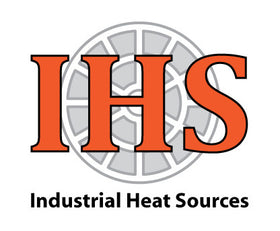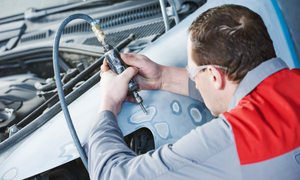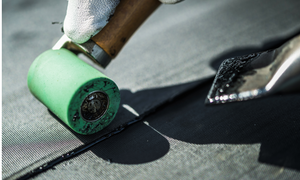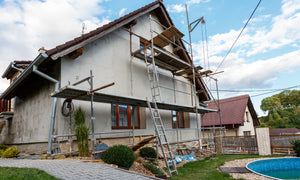Plastic Welding vs. Traditional Sign Repair Methods: Efficiency and Durability

When it comes to sign and banner repairs, the method you choose can significantly impact your efficiency and the durability of the result. Traditional repair methods, such as adhesive bonding or mechanical fastening, have been long-standing practices in the industry. However, plastic welding is an alternative option that offers distinct advantages in terms of efficiency and durability.
Below, learn about the differences between plastic welding and traditional sign repair methods to help you make an informed decision about your repair.
>>Related read: Why Handheld Hot Air Plastic Welding is the Most Efficient Option for Your Sign and Banner Finishing and Repairs
Understanding Traditional Sign and Banner Repair Methods
Traditional sign repair methods often involve mechanical fastening, adhesive bonding, or patching. Each of these methods has its own set of benefits and limitations.
The mechanical fastening method uses screws, bolts, or other fasteners to hold components together. It's a reliable technique for securing parts but can be time consuming and may leave visible marks that detract from the sign's appearance. Additionally, mechanical fasteners can weaken over time, especially when exposed to outdoor elements like wind, rain, and UV radiation.
Adhesive bonding, or tape, offers a clean and seamless finish, making it a popular choice for sign repair. However, the effectiveness of adhesive bonding largely depends on the materials used and the environmental conditions. Over time, adhesives may degrade, leading to potential failures. Temperature fluctuations and moisture can also weaken the bond and compromise the sign's durability.
Patching involves covering a damaged area with a new piece of material. While it can provide a quick fix, patching often leaves a noticeable scar on the sign. Moreover, the patched area may not have the same strength as the original material, leading to further issues down the line.
Understanding Plastic Welding Sign and Banner Repair Methods
Plastic welding is a technique that involves using heat to fuse plastic pieces together, resulting in a repair that is often indistinguishable from the original. This method creates strong, seamless bonds between plastic components, including vinyl, PVC, acrylic, and polycarbonate.
One of the key advantages of plastic welding is its efficiency. The process is relatively quick, allowing for faster turnaround times compared to traditional methods. Once the plastic cools, the repair is complete and ready for use. This efficiency makes plastic welding ideal for both small- and large-scale sign repairs.
Another advantage of plastic welding over traditional methods is durability. Since the repair involves fusing the plastic components together, the resulting bond is often as strong as the original material. This creates a more robust repair that can withstand environmental stresses such as temperature changes, UV exposure, and mechanical strain. In contrast, mechanical fasteners and adhesives are more prone to wear and tear over time, which can lead to frequent maintenance or even sign failure.
>>Related read: How to Execute the 4 Most Common Types of Plastic Welds
Comparing Efficiency and Durability of Plastic Welding and Traditional Methods
When comparing the efficiency of plastic welding with traditional methods, plastic welding has its advantages. The process is faster, often requiring fewer materials and less labor, which can lead to cost savings. For businesses that need quick repairs to minimize downtime, plastic welding offers a compelling solution.
In terms of durability, plastic welding creates a seamless bond that is less likely to fail under stress, providing a longer-lasting repair. This is particularly important for signs exposed to harsh outdoor conditions, where durability is crucial to maintaining the sign's integrity and appearance over time.
>>Related read: 10 Plastic Welding Accessories That Can Instantly Improve Your Efficiency
Considerations and Limitations of Plastic Welding for Sign and Banner Repairs
While plastic welding offers many advantages, it is not without its limitations. The technique requires specialized equipment and trained technicians, which can lead to higher upfront costs. However, these costs are often offset by the long-term savings associated with reduced maintenance and extended sign life.
Additionally, plastic welding is most effective on plastic materials, which means it may not be suitable for signs made from other materials, such as metal or wood. In such cases, traditional methods may still be necessary.
Overall, when it comes to sign repair, choosing the right method is crucial for ensuring both efficiency and durability. Traditional methods like mechanical fastening and adhesive bonding have their place but often fall short in terms of long-term performance. Plastic welding, with its fast application and strong, durable bonds, offers a modern solution that can extend the life of your signs and reduce the need for frequent repairs.
Top Plastic Welding Tools to Use for Sign and Banner Repairs
Once you’ve chosen your repair method, it’s also crucial to use the right tools. The size and material of the repair both play a role in the equipment you need. For example, the following tools can be used for specific applications:
- IHS Type 1600 Hot Air Hand Tool: This hot air hand tool is designed to for smaller thermoplastic welds, including tiles and sheets.
- HSK APX 300-D Digital 120V & 230V Hot Air Tool: Also used for smaller welds, this tool’s rugged construction and ergonomic design make it ideal for sign and banner repairs.
- HSK Plast 1700-RW, 120V & 230V, 20 mm/30 mm Overlap Welding Machine: This machine is a versatile and efficient automatic welding machine ideal for use on medium- to heavy-weight tarps, awnings, and other membranes.
- Forsthoff P2 Automatic Tape Welding Machine: Designed for 50 mm tape welding applications, this machine’s 4000-watt power rating makes it an ideal, cost-effective solution for larger sign and banner repairs.
- HSK Plast 3400-RW, 230V 40 mm Overlap Welding Machine: This machine is a versatile and efficient automatic welding machine ideal for use on heavy tarps, awnings, and other membranes.
- Forsthoff P2 20 mm, 30 mm, & 45 mm Overlap Welding Machine: Also used for larger welds, this machine is designed specifically for overlap welds for tents, tarpaulins, advertising banners, and industrial fabrics.
Additionally, be sure to have accessories like the IHS Silicone Seam Roller, Everhard Seam Tester, Hyde Front-Loading Utility Knife, and Everhard Bent Shears to ensure smooth, clean repairs.
Get The Plastic Welding Tools You Need for Efficient Repairs
On the market to find a plastic welding tool for efficient, long-lasting sign and banner repairs? Look no further than IHS. Here, you can find a variety of hot air tools and accessories— including hot air hand tools, seam rollers, and more—that are designed to meet your specific goals. If you need help selecting the right tool for your application, reach out to us here and we can find the right solution for you. 
- Robert Heater






